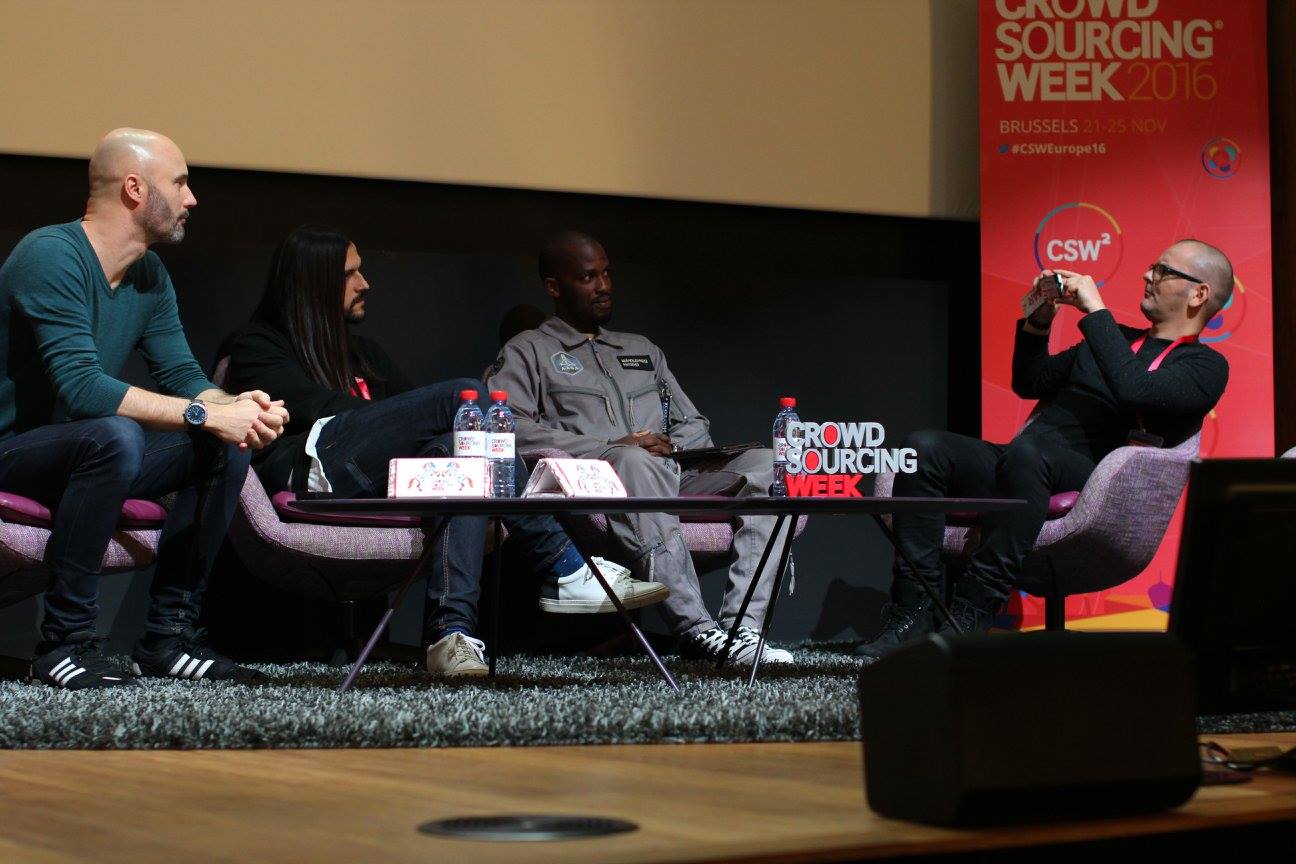This was the title of an impactful, mind-stretching panel session at CSW Europe 2016, held in Brussels 21-25 November. At its heart, what can we learn from issues dealing with space exploration that is transferable to improve life back on Earth?
Karen Eng, a freelance writer and editor who also works with TED.com, introduced the panelists and mediated a discussion on how people outside of the normal scientific elite – in this case three artists involved in space exploration and a trainee astronaut – can help wider humanity (you and me, all of us) better imagine living in outer space which may in turn provoke ideas about living together more sustainably on Earth.
Angelo Vermeulen is a space systems researcher, biologist, artist and community architect who has worked for the European Space Agency. He was a crew commander in a four month NASA-funded exercise in 2013 researching the effects of long-term isolation on small groups of people, including cultivating food to sustain people under conditions replicating living in a base on Mars. Angelo currently works on prototype starship design for interstellar travel for a PhD at Delft University of Technology.
All facets of Angelo’s work focuses on the recirculation of every item that’s involved in a project, and he does it on a ‘bottom-up’ basis, without plans, through co-creation with crowds of contributors. Projects have included using heat waste from recycled electronic equipment to grow biomass products. It was this project that first drew him to the attention of the European Space Agency to develop another project that uses every molecule of waste from the human body to create food for plants, and the plants in turn create oxygen and provide food for astronauts and space communities. The breakthrough technologies this develops can also be used back on Earth.
In working with crowds around the world on starship design and the recirculation of every item they have to consider the ‘rules’ under which the related communities will live together. This can once again lead to developments that can be used by terrestrial governments and authorities.
Frederik De Wilde is a Belgian artist and science innovation consultant who has used carbon to develop a super-dark nano black to create the blackest ever art. Next year some of his art will be taken to the Moon. This world’s blackest material has been used as a coating on the inside of telescopes to improve their effectiveness for space exploration.
What is the challenge of creating sculptural art for the surface of the Moon? For start it hast has no atmosphere and it has far stronger infra-red and ultra-violet light. Can light sensitive polymers be successfully used? Which resins can hold it together? Are there materials available only on the Moon itself that can be used? The exercise presents challenges that don’t exist on Earth, and will require unique solutions that could be beneficially transferrable back.
Some of Frederik’s other work has included investigation of quantum vacuums. We usually believe that extraction of oxygen to create a vacuum in a vessel means it contains nothing at all, though in fact quantum vacuums still contain sub-atomic particles that create energy through matter and anti-matter destroying each other (which I thought was something made up for Star Trek storylines). He has used 3-D printing for artistic exploration of quantum vacuums to let us see representations of these subatomic particles.
Jorge Manes Rubio describes himself as “a sort of sociohistorical alchemist.” And is Artist In Residence for the European Space Agency. He has explored the role of astronomy in historical cultures, establishing that Central and South American pyramids were not only religious temples but also places used to explore the cosmic sky and celestial bodies.
He’s currently collaborating with the European Space Agency on a new art project building a non-denominational temple at the south pole of the Moon. He’s looking at space exploration from a human, anthropological and spiritual perspective. And again there are unique challenges: what will be the architectural style used on the Moon? could a building there be constructed using a 3-D printer?
An audience member quizzed him about the cost of this project and its value at a time when there are still so many unresolved issues on Earth. Jorge’s answer was that a community living far from home and loved-ones in an artificial life-support system may find itself even more dependent on faith. Though what sort of faith? How will births and deaths on the Moon be acknowledged by its community? The moon has no indigenous faiths, no boundaries and no countries. How a Moon community develops its behaviour to share a necessarily limited resource for mutual benefit could be a valuable lesson towards developing the most important set of values for future generations on Earth. Being able to see our whole planet as a single entity can be a powerful benefit, a transformative game changer.
Mandla Maseko won a place in a competition in December 2013 to train as an astronaut for a commercial company. He will Africa’s first coloured spaceman, initially in a non-orbital flight travelling at a speed up to Mach 3 (three times the speed of sound), and he hopes to be the first African to walk on the Moon. Since being accepted for space training he has also become a fighter pilot in the South African Air Force. The main lesson he goes out with and wants to teach young Africans is that any dream is possible through self-belief and determination – after all, that’s all he had to start with. His uplifting, aspirational message at a human level is: “the sky is not the limit.” Space exploration can be used as a metaphor for any great personal challenge.

Key points from the panel discussion were that the speakers agreed giving members of the public a scenario of space exploration really sets people’s imaginations free to step out of their comfort zone and put forward new ideas, solutions and opportunities with a greater openness. At the same time there are practical limitations and challenges through living in remote, isolated communities with finite resources, hence the emphasis on recycling and recirculating everything in ways that are agreed as acceptable to the group, to the crowd. Also, the inclusion of artists with teams of scientists is valuable to devise innovative solutions that are beyond the sometimes bureaucratic institutionalisation of organisations such as ESA and NASA.
And finally, the commercialisation of space travel will open the way to asteroid mining. The profits will be literally astronomical and the leading companies will dwarf the value of the likes of Apple, said Angelo Verleumen. And with their main activity out in space, which – if any – government(s) will they be responsible to for regulation, licensing and tax? Jorge referred to the International Space Treaty that no government can make territorial claims. So for commercial companies it will be like the Wild West on a “first come, first served basis.” This makes it attractive for corporations to invest in space exploration that could open up totally new jobs for many, many people at home on Earth. Though the subsequent distribution of rewards could be a cause for future concern.




0 Comments